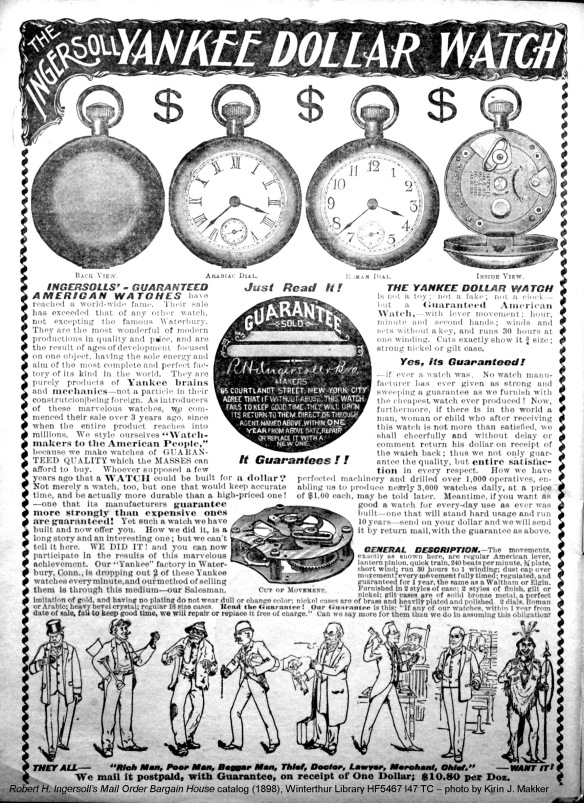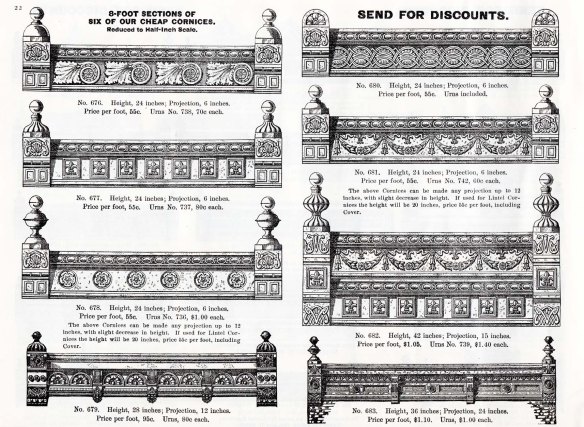![Hoxie, Kansas ca.1900-1910 [photo courtesy of Sheridan County Historical Society, digitized by Flikr member whitewall buick]](https://mythsofmainstreet.files.wordpress.com/2014/05/reduced-hoxie-ks-sheridan-county-historical-society.jpg?w=584&h=340)
What did they sell in these shops? How and where did they get their goods? Image of Main Street in Hoxie, Kansas ca.1900-1910. [courtesy of Sheridan County Historical Society, digitized by Flikr member whitewall buick] fun fact: that storefront on the far left is a Mesker Bros. storefront, ordered out of a catalog and shipped from St. Louis. [confirmation provided by Darius Bryjka]
In early April, I went to the University of Connecticut Archives and Special Collections to spend a couple of days sifting through the records of E. Ingraham Company Records. A major part of my research methodology involves following the trail of company goods right at the moment big capitalism really spread its wings. My hope is to track where a handful of companies sold their goods in order to describe a product’s national distribution, and hence its availability across small town America. I have found, and my research will argue, that one of the reasons that small town America is such a consistent idea in the nation’s cultural language is that the goods exchanged there had both local and national parameters. Some of this research has had to do with companies that literally produced small town America: the storefronts, the brick-making machinery, the lamps and posts. But other parts of the research is about the everyday objects that were sold in small towns, and how most of them during the period of small town America’s boom were not made locally or even regionally. The retailers were locals, but the items for sale on Main Street were typically sourced from manufactories or large distributors in cities. Again, Main Street is tied to the economy of very large cities and vice-versa.
For example, a $2 watch made by the E. Ingraham Company in 1898 was made in Bristol, Connecticut but was sold on several thousand Main Streets all across America in general stores or small jewelry shops. Ingraham was after the mass market that the very successful company Robert H. Ingersoll had been selling to. Ingersoll had shrewdly introduced a $1 pocket watch, the “Yankee,” in 1892, stumbling into an enormous mass market of working- and middle-class consumers interested in owning timepieces they could afford. Most cheaper watches at the time were in the range of $4 to $6.
Although Ingraham couldn’t make a quality watch for that little (the Ingersoll watches, not surprisingly, were cheap but not known for quality), the did start making a $2 watch by 1900 and these sold quite well, judging by how long they produced this watch (until the 1950s). Yet, when I dug around the Ingraham Company archives at UConn, I had some trouble finding records to support their efforts to take a share of the Ingersoll Yankee’s market.As I said, I set out to spend all my time on the Ingraham Clock Co. archive. However, it turned out that what I was really hoping to find within my time period (1870-1930, Main Street’s ‘boom period,’ so to speak), wasn’t so easy to cull. I had set out to identify names and locations of retailers who ordered Ingraham watches for their shops on Main Streets in towns all over the country. Or possibly find advertising by the company that included testimonials from retailers in small towns. I have found these types of testimonials for Elgin watches of the period, so I was hopeful. However, most of the Ingraham Company’s order records at UConn’s Archives and Special Collections show sales to large distributors in cities. In addition, most of the records in the collection were from the 1940s and 50s (just the luck of what records survived, unfortunately). I did find contract letters with Sears from the 1930s, in which the mega-retailer agreed to uniquely market Ingraham watches in their stores and catalogs. But I needed letters with Sears or Montgomery Ward from around 1905 or more information about the distributors who bought $2 watches in large volume and then re-sold them in small batches to shop owners in the nation’s towns. That information may or may not be available in any archives, so in the end, the Ingraham $2 pocket watch story might not make it into the book.
However, as typically happens for me, as soon as I turn my attention away from one enticing collection, I find myself in the midst of a host of material that suits some other aspect of the book research. (Nothing, I tell you, NOTHING beats the fun of serendipity in the archives!)![Ad for Dicksinson's Witch Hazel, manufactured in Middletown, Durham, Guilford, Higganam, Essex, CT between 1875 and 1950s. [Archives and Special Collections UConn]](https://mythsofmainstreet.files.wordpress.com/2014/05/4-witch-hazel-ad-100dpi.jpg?w=584&h=396)
Ad for Dicksinson’s Witch Hazel, manufactured in Middletown, Durham, Guilford, Higganam, Essex, CT between 1875 and 1950s. [Archives and Special Collections UConn]
The story of Dickinson’s Witch Hazel fits right into this chapter because it was a factory-produced astringent that became an everyday remedy for minor ills. It was sold all over the country in drugstores and used extensively in small town doctor’s offices. And this time, I found records that show national distribution. For example, during the mid-1920s there were many letters between Dickinson executives and the Druggist Supply Corporation (DSC). The DSC was made up of retailers across America, many of which were located in small towns (Fresno, CA; Peoria, IL; Ottumwa, IA; Burlington, IA; Fort Wayne, IN; Rock Island, IL among many others). By working with that organization, Dickinson assured that they would get their product into those shop owners’ hands.
![Letter from Middleton Drug Store thanking Dickinson Co. for marketing booklets [E.E. Dickinson Co. Records, Archives and Special Collections, UConn.]](https://mythsofmainstreet.files.wordpress.com/2014/05/6-middleton-drug-store-150dpi-grand-rapids-mi.jpg?w=584&h=567)
Letter from Middleton Drug Store thanking Dickinson Co. for marketing booklets [E.E. Dickinson Co. Records, Archives and Special Collections, UConn.]
![Marketing booklet distributed to drug stores across America in 1920s [Archives and Special Collections UConn]](https://mythsofmainstreet.files.wordpress.com/2014/05/5-witch-hazel-booklet-100-dpi.jpg?w=584&h=805)
Marketing booklet distributed to drug stores across America in 1920s [Archives and Special Collections UConn]
Note: This visit to UConn’s Archives and Special Collections was funded by a 2014 Strochlitz Travel Grant. Travel Grants are awarded bi-annually to scholars and students to support their travel to and research in UConn’s Archives and Special Collections. Fellows are required to submit a blog entry to UConn on the work done at the Collections within six-weeks of their visit. Part of the above report also draws on materials at Winterthur Library, where Dr. Makker is also being supported by a 2013-14 National Endowment for the Humanities residential fellowship. A version of this essay also appears on the UConn Archives and Special Collections Blog.
The team at UConn has uploaded digitized versions of several Ingraham catalogs from the early 20th century. A catalog from 1918-19 can be see here an archive.org.
Dickinson Witch Hazel still exists! The company is now a subsidiary of Dickinson Brands. Their slogan is “The leading name in witch hazel.”
For some fun reading about the use and production of witch hazel by humans, see November 2012 in The Atlantic “The Mysterious Past and Present of Witch Hazel”.


![Contract letter from Sears to Ingraham Co. [UConn Archives and Special Collections]](https://mythsofmainstreet.files.wordpress.com/2014/05/3-bw-sears.jpg?w=584&h=889)






